During this “Norming” phase clear leadership is needed, after the “Storming” period where players are looking for their position in the team
Intro
Perhaps the Tuckman model is a bit outdated now, these are re-posts from a bit back in time. Do we have time now to go through this team development cycle? Do we still approach this as in phases?
The coach AND senior players should take his responsibility and bring the players together and discuss the way everybody in the team should interact on and off the pitch. Things to do are setting up team meetings, have individual meetings, appoint a captain, develop a Code of Conduct and set-up and define functional roles, plays and scenario’s.
Remember, you as the coach are key to create an atmosphere in which players feel free to express themselves. Certainly in youth teams. Some of my experiences are discussed on this page.
Functional Roles
What do you want your players to do and what do want them not to do? A lot of mistakes can be prevented from happening if you clarify this to your players. Once you have defined what responsibilities come with each position, players will have to accept those responsibilities and can focus on performing those tasks.
You can easily bring more structure in your team by discussing these issues. You will be amazed by how quickly most players will accept these roles.
It will also start your Skillmix Optimisation process: how to get all the positions filled with the available players.
Code of Conduct
Why do you need a code of conduct? Because it describes how players / coaches socially behave, how players should interact and because the Code of Conduct is set up by the team everybody has to live by it.
I remember an after the game discussion with the team where I started with “If this is what we are as a team, I do not want to be a part of it”. One of the players then reminded us all about the Code and that we all signed up to it…..
Norming and “Moves”
“When do we start learning team plays?”. All the time this question. I understand why players want to practise set plays, but in most cases it is just a strange need for security, hiding from taking initiative and responsibility. If something goes wrong, nobody is able to adjust. What I did with the National Under 18 was the following.
- We had a whole afternoon practising set plays, everybody was confident it would go like a dream that evening in our practise game….. but it did not. I used video to show them that we lost a lot of opportunities because we did not look at the gaps anymore but at all the (dummy) runners.
- I also showed them moves where they did not follow the plan but improvised: “Do we stick with the planned move? do we need better moves? Or do we follow our rugby instincts?”
- We then had a good discussion when set plays will have a role in our play AND when not.
The result? Players are now aware why they do moves, can decide on the where and when and can think of ‘Plan B’ emergency options when things go different.
Individual discussions
When players don’t interact (behave socially) you may need to kick them out. They disturb the concentration of all the others and kill the pleasure of playing for everybody. I switched a player from fly-half to full-back to get him out of the centre of things. Actually, this turned out quit well: he could join the attack in a more suited free role, the new 10 brought a bit more structure and better distribution and my 9 was not arguing all the time!
Sometimes players put other players off with their well intended remarks, I always want players to focus on their own tasks (i.e. the coach coaches and the players play).
More on:
- Introduction on teambuilding;
- Forming: more on bringing players together and why you should consider bringing foreign players in your team;
- Storming: examples of problems I had to solve coaching;
- Performing: gameplan, evaluation and goal setting;
Subscribe and get notified when I add new posts to the Blog;

1 comment for “Norming in Team Dynamics”